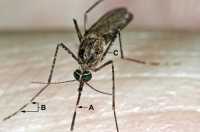
01 May West Nile Virus: Lag Time in Reporting Precludes Accurate Public Health Decisions
MedicalResearch.com Interview with:
Nicholas B. DeFelice, PhD
Department of Environmental Medicine & Public Health
Icahn School of Medicine at Mount Sinai
New York, New York
MedicalResearch.com: What is the background for this study? What are the main findings?
Response: Effective allocation of public health resources during an outbreak is complicated and often reactive. Thus, it is important that we develop quantitative tools that can accurately and rapidly forecast the progression of an outbreak and provide decision support. Recently, several advancements have been made in the realm of infectious disease forecasting: it is a field that is growing in exciting directions. However, for these forecasting tools to work in real time, we must understand how the forecasting apparatus and observational network work in real time to ensure they are sufficient to support accurate operational predictions.
We previously showed that accurate and reliable forecasts of West Nile virus outbreaks can be made using surveillance data and a mathematical model representing the interactions between birds, mosquitoes and risk of human spillover. This model system was able to retrospectively forecast mosquito infection rates prior to the week of peak mosquito infection, and to forecast accurately the seasonal total number of human West Nile virus cases prior to when the majority of cases were reported.
For this study, we were interested in the data flow process and the question of whether appropriate infrastructure is in place to support real time forecasting. If this forecast system were made operational in real time, public health officials would have an evidence-based decision-support tool to help
1) actively target control of infected mosquito populations (i.e., larviciding and adulticiding),
2) alert the public to future periods of elevated West Nile virus spillover transmission risk, and
3) identify when to intensify blood donor screening.
MedicalResearch.com: What are the main findings?
Response: Our main findings were that delays in reporting human West Nile disease and infected mosquito information were associated with a reduction in average West Nile virus forecast accuracy. Infected mosquito lags were short enough that skillful forecasts could still be generated for mosquito infection indicators, but the lag associated with confirmed human West Nile virus case-reporting precluded accurate forecasting in real time. For public health departments and mosquito abatement districts to integrate forecasting effectively into operational decision-making, the relaying of real-time health and environmental surveillance data should be prioritized.
MedicalResearch.com: What should readers take away from your report?
Response: In order to interrupt the spread of infectious diseases, a great deal of effort goes into monitoring and preventive measures. However, as shown here, under the current reporting protocols, medical professionals, public health departments and mosquito abatement districts are making critical decisions with limited real-time data. As society moves to electronic medical records and improvements are made in pathogen testing, these reporting lags can be reduced, providing more information for all stakeholders who are involved in preventing the spread of arbovirus infections. However, to reduce these reporting lags, resources are needed and should be a priority to improve health.
MedicalResearch.com: What recommendations do you have for future research as a result of this work?
Response: More work is needed in order to understand the disease reporting process and how streamline it to produce reliable real-time data streams. This would provide public health professionals with more robust real-time data, which would ideally result in improved outbreak prevention measures.
For example, the reporting process for West Nile virus goes through several stages. First, a person becomes ill; they then make a decision to seek medical care and see a doctor; the doctor identifies signs of West Nile virus and orders a lab test; information is first reported to the health department when the lab test is ordered; a varying number of days later the lab results confirm or deny a human case; and, if positive, the health department determines if it is locally acquired and the date of onset. Each step of this process provides more information on a reported case and a greater understanding of this process can reduce reporting lags and provide more timely robust data for forecasting.
MedicalResearch.com: Is there anything else you would like to add?
Response: As we approach summer, we should all be aware of ways to reduce our risk of West Nile virus or other vector-borne diseases. The best way to avoid being bitten by a mosquito is by reducing exposure. This may be done by limiting breeding sites, which can involve removing standing pools of water (e.g. bird baths), or treating them with a larvicide. In addition, one can use mosquito repellent (CDC recommends 30% DEET or Picaridin), wear long pants, and install window screens.
Citation:
[wysija_form id=”3″]
[last-modified]
The information on MedicalResearch.com is provided for educational purposes only, and is in no way intended to diagnose, cure, or treat any medical or other condition. Always seek the advice of your physician or other qualified health and ask your doctor any questions you may have regarding a medical condition. In addition to all other limitations and disclaimers in this agreement, service provider and its third party providers disclaim any liability or loss in connection with the content provided on this website.
Last Updated on May 1, 2019 by Marie Benz MD FAAD

